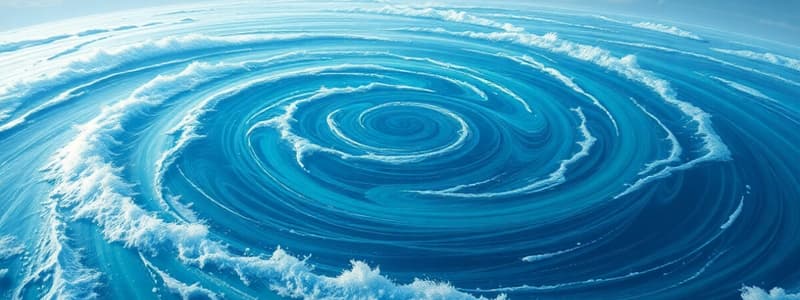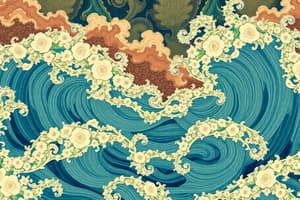Podcast
Questions and Answers
What primarily drives surface currents in the ocean?
What primarily drives surface currents in the ocean?
- Underwater topography
- Salinity differences
- Thermal expansion of water
- Wind (correct)
What is the Coriolis effect related to?
What is the Coriolis effect related to?
- Changes in water temperature
- Salinity variations in ocean water
- The rotation of the Earth (correct)
- Pressure systems in the atmosphere
How do continents affect oceanic currents?
How do continents affect oceanic currents?
- They enhance the speed of currents
- They generate upwelling zones
- They create whirlpools
- They prevent the continuous flow and deflect water (correct)
What is a gyre?
What is a gyre?
What role does friction play in ocean currents?
What role does friction play in ocean currents?
Which factor is NOT responsible for the formation of deep ocean currents?
Which factor is NOT responsible for the formation of deep ocean currents?
What characterizes thermohaline circulation within the ocean?
What characterizes thermohaline circulation within the ocean?
Which description best defines deep currents?
Which description best defines deep currents?
Which of the following statements about surface currents is accurate?
Which of the following statements about surface currents is accurate?
What is the primary force that causes the equatorial currents to turn at the western boundary of the ocean basin?
What is the primary force that causes the equatorial currents to turn at the western boundary of the ocean basin?
Which winds contribute to the formation of equatorial currents in the ocean?
Which winds contribute to the formation of equatorial currents in the ocean?
Why cannot equatorial currents cross land when they reach the western boundary of an ocean basin?
Why cannot equatorial currents cross land when they reach the western boundary of an ocean basin?
In which hemisphere do trade winds blow from the northeast toward the equator to create currents?
In which hemisphere do trade winds blow from the northeast toward the equator to create currents?
What is the effect of the Coriolis force on equatorial currents as they move toward the western boundary?
What is the effect of the Coriolis force on equatorial currents as they move toward the western boundary?
What is the primary characteristic of western boundary currents?
What is the primary characteristic of western boundary currents?
What type of water do eastern boundary currents transport?
What type of water do eastern boundary currents transport?
Which statement accurately describes the flow direction of western boundary currents?
Which statement accurately describes the flow direction of western boundary currents?
How do western boundary currents differ from eastern boundary currents in terms of water temperature?
How do western boundary currents differ from eastern boundary currents in terms of water temperature?
Which of the following statements is false regarding western and eastern boundary currents?
Which of the following statements is false regarding western and eastern boundary currents?
What occurs as a result of the wind's friction force on ocean surface waters?
What occurs as a result of the wind's friction force on ocean surface waters?
At what depths does Ekman transport primarily affect ocean water?
At what depths does Ekman transport primarily affect ocean water?
How does the movement of ocean water change with depth during Ekman transport?
How does the movement of ocean water change with depth during Ekman transport?
Which statement correctly describes the impact of wind on ocean surface waters?
Which statement correctly describes the impact of wind on ocean surface waters?
Which of the following best describes the relationship between surface and subsurface ocean currents as a result of Ekman transport?
Which of the following best describes the relationship between surface and subsurface ocean currents as a result of Ekman transport?
What does Ekman transport lead to in terms of ocean water movement?
What does Ekman transport lead to in terms of ocean water movement?
What is the primary principle that governs Ekman transport?
What is the primary principle that governs Ekman transport?
Which process replenishes water that is displaced due to Ekman transport?
Which process replenishes water that is displaced due to Ekman transport?
How does wind influence Ekman transport?
How does wind influence Ekman transport?
Which statement accurately describes the outcome of Ekman transport in ocean environments?
Which statement accurately describes the outcome of Ekman transport in ocean environments?
What is the depth range at which the Ekman spiral occurs?
What is the depth range at which the Ekman spiral occurs?
What is the relationship between the average direction of water movement in the Ekman spiral and the wind direction?
What is the relationship between the average direction of water movement in the Ekman spiral and the wind direction?
How does the Coriolis effect influence ocean water movement within the Ekman spiral?
How does the Coriolis effect influence ocean water movement within the Ekman spiral?
What does the term Ekman transport refer to?
What does the term Ekman transport refer to?
What does the diagram of the Ekman spiral primarily illustrate?
What does the diagram of the Ekman spiral primarily illustrate?
Which gyre is located in the North Atlantic Ocean?
Which gyre is located in the North Atlantic Ocean?
What is the name of the gyre found in the Indian Ocean?
What is the name of the gyre found in the Indian Ocean?
Which gyre is associated with the South Pacific Ocean?
Which gyre is associated with the South Pacific Ocean?
Which of the following gyres is found in the North Pacific?
Which of the following gyres is found in the North Pacific?
Which gyre corresponds to the South Atlantic region?
Which gyre corresponds to the South Atlantic region?
What is the direction of surface water deflection due to Ekman transport in the Northern Hemisphere?
What is the direction of surface water deflection due to Ekman transport in the Northern Hemisphere?
What phenomenon occurs due to the convergence of water in the center of a gyre?
What phenomenon occurs due to the convergence of water in the center of a gyre?
How does the height of the water pile up in the center of a gyre typically measure?
How does the height of the water pile up in the center of a gyre typically measure?
Which of the following best describes the rotation direction of gyres in the Northern Hemisphere?
Which of the following best describes the rotation direction of gyres in the Northern Hemisphere?
What does the convergence of water in gyres lead to?
What does the convergence of water in gyres lead to?
What primarily causes the fast and deep nature of western boundary currents?
What primarily causes the fast and deep nature of western boundary currents?
How does the Coriolis effect influence the structure of ocean gyres?
How does the Coriolis effect influence the structure of ocean gyres?
What would be the shape of ocean gyres without the Coriolis effect?
What would be the shape of ocean gyres without the Coriolis effect?
What characteristic is significant regarding the western boundary currents compared to eastern boundary currents?
What characteristic is significant regarding the western boundary currents compared to eastern boundary currents?
What diagrammatic representation indicates the actual flow pattern of ocean gyres including the Coriolis effect?
What diagrammatic representation indicates the actual flow pattern of ocean gyres including the Coriolis effect?
Flashcards
Ocean Current
Ocean Current
A flowing mass of water in the ocean
Surface Currents
Surface Currents
Ocean currents driven mostly by wind.
Coriolis Effect
Coriolis Effect
Earth's rotation that influences ocean currents.
Ocean Gyre
Ocean Gyre
Signup and view all the flashcards
Continents
Continents
Signup and view all the flashcards
Deep Currents
Deep Currents
Signup and view all the flashcards
Thermohaline Circulation
Thermohaline Circulation
Signup and view all the flashcards
Density Differences
Density Differences
Signup and view all the flashcards
Trade winds
Trade winds
Signup and view all the flashcards
Equatorial currents
Equatorial currents
Signup and view all the flashcards
Western boundary currents
Western boundary currents
Signup and view all the flashcards
Columbus Gyre
Columbus Gyre
Signup and view all the flashcards
Navigator Gyre
Navigator Gyre
Signup and view all the flashcards
Turtle Gyre
Turtle Gyre
Signup and view all the flashcards
Heyerdahl Gyre
Heyerdahl Gyre
Signup and view all the flashcards
Majid Gyre
Majid Gyre
Signup and view all the flashcards
What's the difference between Eastern & Western Boundary Currents?
What's the difference between Eastern & Western Boundary Currents?
Signup and view all the flashcards
Why are Western Boundary Currents fast?
Why are Western Boundary Currents fast?
Signup and view all the flashcards
How do Western Boundary Currents affect climate?
How do Western Boundary Currents affect climate?
Signup and view all the flashcards
Ekman Transport
Ekman Transport
Signup and view all the flashcards
Wind Friction
Wind Friction
Signup and view all the flashcards
Ekman Spiral
Ekman Spiral
Signup and view all the flashcards
Ekman Layer
Ekman Layer
Signup and view all the flashcards
Surface Layer
Surface Layer
Signup and view all the flashcards
How deep does the Ekman spiral extend?
How deep does the Ekman spiral extend?
Signup and view all the flashcards
Ekman Suction
Ekman Suction
Signup and view all the flashcards
Ekman Pumping
Ekman Pumping
Signup and view all the flashcards
Mass Conservation
Mass Conservation
Signup and view all the flashcards
How does Ekman transport impact biogeochemical properties?
How does Ekman transport impact biogeochemical properties?
Signup and view all the flashcards
Geostrophic 'Hill'
Geostrophic 'Hill'
Signup and view all the flashcards
How Does Earth's Rotation Affect Ocean Gyres?
How Does Earth's Rotation Affect Ocean Gyres?
Signup and view all the flashcards
What causes water to pile up in the center of a gyre?
What causes water to pile up in the center of a gyre?
Signup and view all the flashcards
Gyre
Gyre
Signup and view all the flashcards
How does a gyre create a 'hill' of water?
How does a gyre create a 'hill' of water?
Signup and view all the flashcards
What does the 'hill' of water in a gyre mean?
What does the 'hill' of water in a gyre mean?
Signup and view all the flashcards




